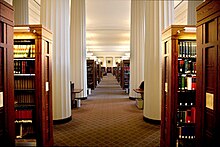Langdell Hall
| Langdell Hall | |
|---|---|
 | |
 | |
| General information | |
| Type | Library |
| Architectural style | Modified neoclassical |
| Location | Harvard Law School |
| Town or city | Cambridge, Massachusetts |
| Country | United States |
| Coordinates | 42°22′39″N 71°07′06″W / 42.3774°N 71.1183°W |
| Named for | Christopher Columbus Langdell |
| Year(s) built | 1905–1907 |
| Renovated | 1928–1929, 1997 |
| Cost | $365,000 |
| Renovation cost | $1,500,000 (1928–1929) |
| Technical details | |
| Material | Limestone |
| Design and construction | |
| Architect(s) | Shepley, Rutan and Coolidge |
| Renovating team | |
| Renovating firm | Coolidge, Shepley, Bulfinch, and Abbot (1928–1929) Shepley, Bulfinch, Richardson and Abbott (1997) |
Langdell Hall is the largest building of Harvard Law School in Cambridge, Massachusetts. It is home to the school's library, the largest academic law library in the world, named after pioneering law school dean Christopher Columbus Langdell. It is built in a modified neoclassical style.
Construction and design
[edit]

The building was commissioned in 1905 by law school dean James Barr Ames, as the school was outgrowing H. H. Richardson's Austin Hall. It was designed by Richardson's successor, the firm Shepley, Rutan and Coolidge.[1] The southern wing of the current building was completed and occupied by the autumn of 1907 and the first lecture in the new building was delivered on October 17, 1907. By the start of 1908, nearly the entire building was being used.
The building was built with buff limestone in a modified neoclassical style. The frieze is inscribed with the maxim, "Non Sub Homine Sed Sub Deo Et Lege" from Henry de Bracton, meaning "Not under Man, but under God and Law." The front features Ionic columns and the interior woodwork throughout the building was dark oak. The library stack was designed to ultimately hold 300,000 volumes. A subway was built to connect neighboring Austin Hall. The cost of construction was $365,000.[2]
The same firm, under the name Coolidge, Shepley, Bulfinch and Abbott, completed a $1,500,000 enlargement of the building in 1929 and including the addition of the northern and western wings.[3]
In 1959, the International Legal Studies building, now the Lewis International Law Center, was constructed to house approximately 300,000 volumes in open-stacks.
In 1997, Shepley, Bulfinch, Richardson and Abbott was appointed once again, this time to renovate the building. The renovations expanded the library, which now takes up most of the building, with the exception of two classrooms—the Vorenberg and Kirkland & Ellis. The renovation also included the installation of air conditioning and additional women's restrooms.
Other notable parts of the building include the Caspersen Room, named for HLS alumnus Finn M. W. Caspersen (J. D. 1966). The Caspersen Room, formerly called the Treasure Room, once housed part of the library's collection of rare books and manuscripts. The lobby of the building is graced by a statue of Joseph Story, Harvard professor and Supreme Court justice, sculpted by his son, William Wetmore Story.
References
[edit]- ^ "Opening of Langdell Hall: New Law School Building Ready for Occupancy Next Week". The Harvard Crimson. September 26, 1907.
- ^ Wambaugh, Eugene (June 1908). "Langdell Hall and the Earlier Buildings of the Harvard Law School". The Green Bag. XX (6): 297–305 – via Internet Archive.
- ^ "Construction of Additions to Langdell Hall Will Start Soon: Elaborate Features Planned for Ideal Law School Plant--All Departments Benefit". The Harvard Crimson. May 17, 1928.
